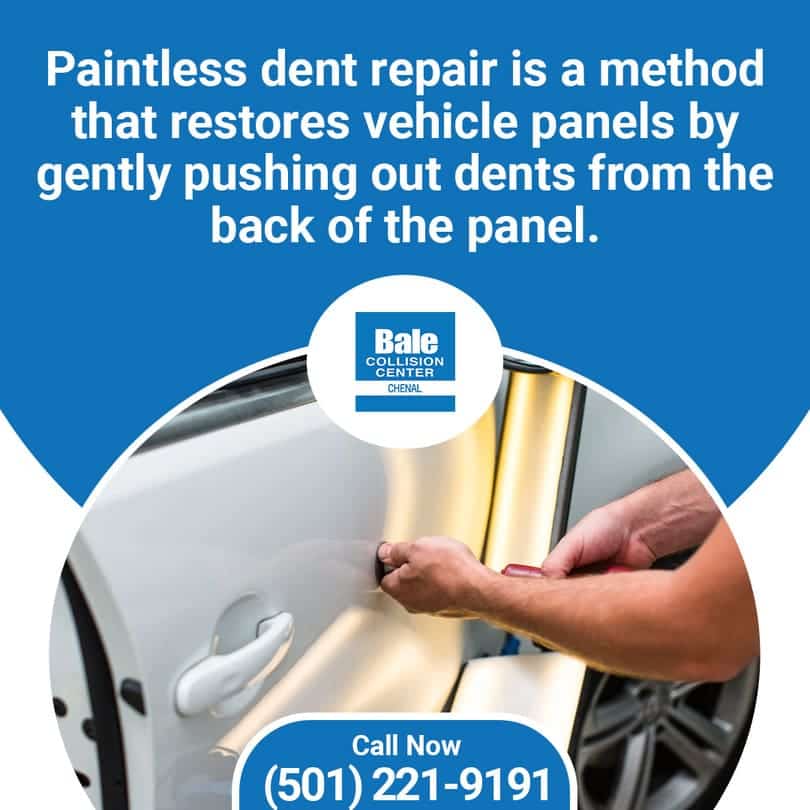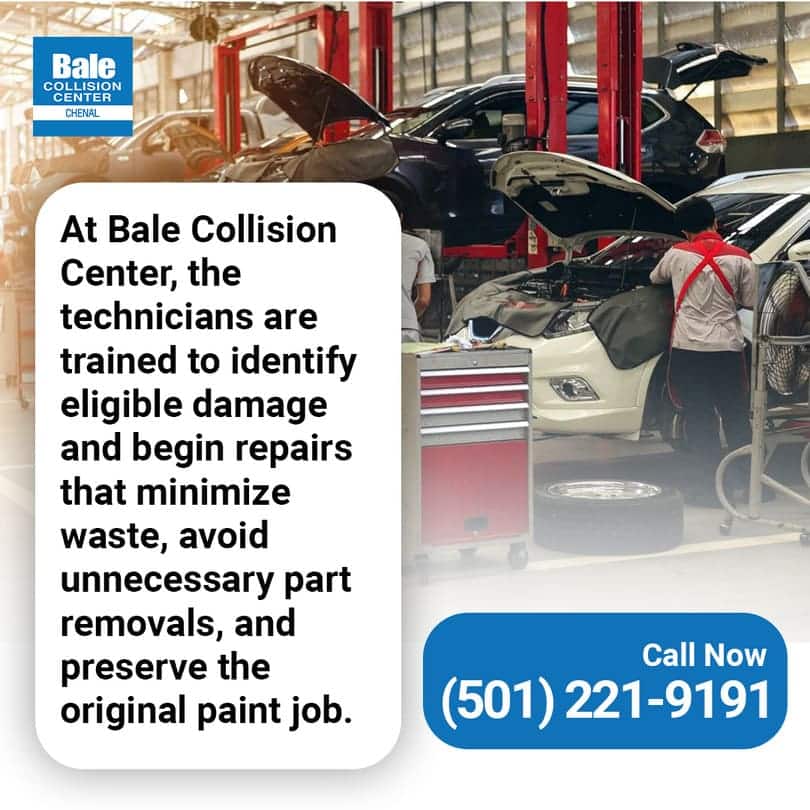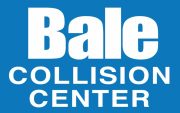Paintless dent repair (PDR) reduces environmental harm by avoiding chemicals, reducing waste, and lowering energy use. Unlike traditional methods that rely on sanding, body fillers, primers, and paint, PDR works by gently reshaping the metal from behind the panel. This means fewer harmful emissions, no paint residue, and minimal use of shop materials. Choosing paintless dent repair near you for hail damage, dings, and small dents reduces waste and helps limit air and water pollution in your local community.
At Bale Collision Center (Chenal), we take an eco-conscious approach and recommend paintless dent repair in Little Rock whenever it’s a suitable option. This article explains how PDR works, compares it with conventional repairs, and shows how we apply smarter repair methods that support a cleaner, healthier environment.

The Broader Impact of Auto Body Repairs
What Happens Beyond the Repair Shop
Traditional auto body repairs create harmful emissions, generate waste, and leave lasting effects on local air and water. Processes like sanding, priming, and repainting release volatile organic compounds (VOCs), which contribute to air pollution and smog. VOCs are found in many paints, thinners, and fillers.
According to the U.S. Environmental Protection Agency (EPA), VOCs from automotive refinishing operations can remain in the air and impact indoor and outdoor air quality. The paint and filler products used in standard repairs don’t just vanish after the repair is done. These materials break down slowly and can leach into the soil or water supply if improperly disposed of. Over time, this adds to the environmental footprint of each repair job.
Since PDR doesn’t involve painting or filler, it avoids these byproducts altogether. That makes it a cleaner choice for anyone looking for low-impact solutions.
The Repair Lifecycle Most Customers Don’t See
Waste Generation from Sanding, Masking, and Repainting
Traditional repairs produce large amounts of physical waste, including dust, paper, and chemical residue. When a vehicle is sanded, layers of paint and filler are removed, creating fine dust particles. These particles contain heavy metals and toxins.
During repainting, technicians use tape, plastic sheeting, and paper to mask off areas that shouldn’t be painted, like windows, trim, or nearby panels. These materials are used once and then discarded, adding to repair-related waste.
In contrast, paintless dent repair shops generate almost no waste during the repair. Technicians use hand tools and controlled pressure to reshape the panel, which eliminates the need for sanding or masking.
What Happens to Leftover Materials and Runoff
Leftover paint, primer, and solvents often end up as hazardous waste or runoff that pollutes water systems. Under U.S. federal law, auto body shops are required to manage used paint, solvents, and related waste in compliance with hazardous waste regulations outlined by the Environmental Protection Agency (EPA) under the Resource Conservation and Recovery Act (RCRA). But improper storage or leaks still happen. Runoff from rinsing equipment or cleaning spray guns can carry chemicals into drains, eventually entering local waterways.
The risk of runoff is always higher with paint-based repairs. Choosing paintless dent repair near you avoids this risk entirely, as PDR uses no paints, no thinners, and no contaminated rinse water.
At Bale Collision Center, we use paintless dent repair to cut waste, lower emissions, and reduce environmental harm. It also keeps your original paint, protects your car’s value, and gets you back on the road faster.
A Cleaner Method: How Paintless Dent Repair Works
Surface-Level Precision Without Surface Damage
Paintless dent repair reshapes panels from the inside without damaging paint or using chemicals. Technicians access the dent from behind the panel using specialized tools. They gently press and massage the metal back into place without removing paint or coatings. This method works best for small to medium dents caused by hail, parking mishaps, or light collisions.
No sanding is required. No primer, filler, or repainting is involved. This also means there’s no need for a full teardown of doors or panels, which saves time and avoids disturbing other parts of the vehicle.
Paintless dent repair provides a quick turnaround and less disruption to the car’s original finish. More importantly, it avoids all the byproducts associated with conventional repair methods.
How This Method Avoids Environmental Harm
Paintless dent repair eliminates paint waste, chemical runoff, and airborne dust from sanding or spraying. As PDR doesn’t use paints, solvents, or body fillers, there’s no chemical exposure for technicians or customers at paintless dent repair shops. It also prevents VOCs from entering the air.
Automotive topcoat VOC contents vary widely—often ranging from 2 to 5 pounds per gallon depending on formulation—so avoiding repainting entirely can significantly cut VOC emissions. PDR completely avoids this step, reducing air pollution in both the repair shop and the surrounding area.
Since sanding isn’t part of the process, there’s no dust buildup or waste from masking materials. This also eliminates the need to filter airborne particles, which would otherwise require energy and maintenance.
By choosing a paintless dent repair shop, customers are supporting cleaner practices that protect workers, reduce emissions, and cut down on chemical waste while restoring vehicle appearance effectively.
Side-by-Side: Environmental Costs of Traditional vs. Paintless Methods
Resource Use
Traditional repairs require more materials and energy than paintless dent repair. Body fillers, primers, masking paper, sanding blocks, and gallons of paint used in conventional methods add to the volume of supplies used per job. By comparison, paintless dent repair relies only on hand tools and access points.
Paint booths also consume large amounts of energy. They need consistent airflow, heat, and lighting to maintain safe and effective conditions for spraying. A standard automotive spray booth can consume significant energy during each cycle. For example, San Diego Gas & Electric reports that ventilation and drying systems in these booths can draw over 18 kilowatts of power during operation.
At Bale Collision Center, we perform PDR without using paint booths or powered sanding systems. For customers looking for efficient paintless dent repair in Little Rock, this means lower energy use and fewer emissions during the repair process.
Waste Generation
Each painted panel generates solid and liquid waste. Paint mixing cups, solvent-soaked cloths, and containers must be disposed of as hazardous material. Masking tape and plastic sheeting used to block overspray are single-use and non-recyclable. Filters in spray booths must be replaced regularly due to particle buildup.
This is one reason why more vehicle owners are turning to paintless dent repair shops. It’s a solution that cuts down on the physical waste that ends up in landfills or requires special disposal.
Local Change, Local Results: Supporting Responsible Repair in Little Rock
Reducing Unnecessary Transport
Choosing paintless dent repair near you can reduce fuel use and emissions. Long-distance vehicle transport to specialty centers increases fuel consumption. A round trip of just 40 miles can burn over a gallon of gas, depending on the vehicle type. That adds up quickly for large vehicles or fleet repairs.
Selecting a local provider like Bale Collision Center for paintless dent repair in Little Rock avoids unnecessary mileage and keeps your transport emissions lower.
Lowering Community Emissions
High shop turnover and constant paint use can increase local air pollution. VOC emissions that come from paint, primer, and solvents used during surface prep and finishing can build up in enclosed areas or dense neighborhoods, especially with multiple jobs per day. Shops with higher repair volume may change booth filters more often and dispose of more chemical containers. This raises the overall environmental burden in the immediate area.
As paintless dent repair avoids the use of paints and solvents altogether, it keeps VOC emissions near zero. For Little Rock customers seeking cleaner alternatives, this method offers a way to improve vehicle appearance without affecting air quality.

Why Bale Collision Center Prioritizes Environmentally Low-Impact Options
Training and Techniques
At Bale Collision Center, we don’t treat paintless dent repair (PDR) as a side option. It’s one of the first solutions we look at when a vehicle comes in with dents or dings. Our technicians are trained to assess whether a dent can be fixed without disturbing the paint. If it qualifies, we move straight into reshaping the panel from behind.
This approach helps us avoid generating dust, paint particles, and chemical waste. It also keeps our shop’s footprint smaller by reducing how many disposable supplies we use. We’ve invested in the right tools and training so we can make the most of this method every time it’s available. By making PDR a core part of our work, we reduce energy use, chemical runoff, and waste production while staying efficient.
Results That Don’t Compromise Quality
We use paintless dent repair to preserve your vehicle’s original finish and long-term value. Factory paint is designed to last. The moment it’s sanded or repainted, the protective layer is altered. Traditional methods often require that, even for shallow dents. But with paintless dent repair in Little Rock, we avoid disturbing the paint entirely.
This matters if you ever plan to trade in or sell your vehicle. A body panel that’s never been repainted typically holds value better than one that has. It also means you’re less likely to see premature paint issues down the road.
We’ve seen how PDR lets us fix dents quickly and cleanly while protecting your investment. There’s less downtime, less disruption, and far less waste. Every time we use this method, we know we’re delivering a result that’s better for you and better for the environment we all share in Little Rock.
Forward-Facing Repair Decisions
Small Changes That Add Up
Choosing lower-impact repair options helps reduce environmental harm over the life of a vehicle. Even minor body damage can lead to major waste if handled using high-material methods. That’s why we promote paintless dent repair in Little Rock whenever it’s appropriate. It uses fewer materials, creates less waste, and avoids unnecessary disruption to the vehicle’s original finish.
By offering this method, we make it easier for our customers to choose an option that supports sustainability without giving up on quality or results.
Why PDR Should Be the Standard for Minor Body Work
With fewer VOCs released into the air and fewer disposables sent to the landfill, it’s a cleaner method that aligns with what responsible repair should look like today. The industry should move toward making PDR the first option for qualifying repairs, not the alternative. That’s why we continue to invest in it and recommend it to customers who want both a solid repair and a smaller footprint.
Choosing Better Repairs for Your Car and the Environment
At Bale Collision Center, we recommend paintless dent repair not just because it works but because it makes sense for the environment and our community in Little Rock. It reduces waste, avoids harmful chemicals, and keeps your factory finish intact.
By choosing a paintless dent repair shop, you’re not only taking care of your vehicle, but you’re also reducing unnecessary emissions and chemical exposure in your area. If you’re searching for paintless dent repair near you or want to learn whether PDR is right for your vehicle, we’re here to guide you through that choice.
Contact Bale Collision Center at (501) 221-9191 or bccwlr@baleautomotive.com to speak with our team about low-impact repair options that protect both your vehicle and the environment. We’re here to help you choose the right solution, right here in Little Rock.
